Systems Analysis and Design for SMEs ICT3021
- Subject Code :
ICT3021
Part A
Identification of Stakeholder
Stakeholders for Swift Delivery Solutions can be divided into internal and external groups. Both of these company groups hold a major influence on this system. The owner of this company is in charge of making decisions. John Smith is the owner of the company. He is in charge of allocating decisions. Not only that he is also supervising operations. Being the owner of the company he is one of the main internal stakeholders. He has contributed to the definition of the functional as well as nonfunctional needs of the system. It becomes crucial day by day. In the section on stakeholders, workers are included. More specifically workers who work in the warehouse. Not only that, delivery workers are also included. In this case, feedback from them is important for the company. It is essential to maintain the usability of the system. Maintaining effectiveness in managing deliveries is also important. Managing pickups and package handling is becoming effective through their regular interactions.
The most important category of external stakeholders is composed of customers (Wood et al., 2021). These clientele depend on the courier service. It also comprises both corporate and private users. Particularly corporate clients are probably going to have more sophisticated requirements. For instance, monthly billing and thorough shipment tracking are some examples of client requirements. To improve the design phase customer feedback is important. It will improve the system's usability (Glaveli, 2021).
Along with the usability, it ensures features are in line with the expectations of regal users. Swift Delivery Solutions can verify its online order system with tracking live functions. It happens through the help of feedback surveys and interviews. It becomes helpful for customers' expectations. Corporate clients could ask for specialized tracking with the tracking facility they will also ask for reporting capabilities (Huml & Cintron, 2021). All these systems could enhance customer satisfaction. These are helpful to encourage repeat business.
Potential future stakeholders for Swift Delivery Solutions could include technology companies. Their involvement is the reason for hardware and software systems. Business partners could extend services that are related to the company. Logistics companies and regulatory bodies are some examples of extended services. Those services could ensure local transport and data privacy laws. Freeman defined it as understanding the reflection of stakeholders. He stated that recognizing and attending to every demand of stakeholders. It becomes significant for the long-term survival of the business. It has been neglecting the needs of any one group. That can result in inefficiencies in the system or legal issues. It is required to build a scalable table to bring stakeholders together (Belyaeva et al., 2020). The workable system requires awareness of the customer's requirements.
Determining System Requirements
To obtain system requirements the company must use surveys, observations, and interviews. Day by day it becomes efficient. Conducting interviews with John Smith and his staff is crucial to comprehend the operational obstacles. Those obstacles must be encountered by them. Employees may have opinions about the way the company handles packages (Hampel et al., 2020). In the necessity of having real-time data access there will also be the opinion of employees. The opinion of stakeholders became essential when John shed light on the difficulties in arranging pickups and deliveries. All observations are made in the warehouse. The reason for this is during deliveries observation would highlight inefficiencies and bottlenecks in the system. Delays in package processing and poor driver communication are some glimpses of inefficiencies. It is important to gather order tracking and billing options. These are entered as per the preferences of customers for system features. The collecting process would be completed by distributing surveys to customers.
During the procedure it is important to address some major questions:
Owner- John Smith:
- What difficulties do you have most often at the time you are handling client requests and delivery schedules?
- What precise information, do you need to track to maintain operational efficiency like package status or customer details?
- As the company grows, how do you see the system developing?
Workers (Delivery and Warehouse Personnel):
- What difficulties come up during the package processing and delivery coordination process?
- In what ways may technology enhance your daily operations, like communication and tracking?
Clients (Business and Individual):
- What functionalities would enhance your ordering experience, like real-time tracking or payment alternatives?
- What method of receiving delivery updates would you prefer?
- After asking specific questions, it ensures the system satisfies the user and operational requirements as per the expansion plan of Swift Delivery Solution.
Primary Functional Requirements
Having the aim to streamline the courier and delivery operations Swift Delivery Solutions has to incorporate some functionalities. Order management is one of the first critical requirements that allows customers to submit online delivery requests (Laplante & Kassab 2022). Item weight, preferred delivery times, and pickup with delivery locations must be recorded by the system. All these factors are included in the important information. The scenario emphasizes how important it is to track the status of every box. It is necessary that the system needs to provide customers and internal workers with real-time package tracking (Chazette & Schneider, 2020). This can capture timestamps at every stage. Timestamps include pickup, warehouse arrival, and ultimate delivery.
Moreover, necessary is a feature for billing and invoicing. Monthly statements are frequently requested by corporate clients. That is the reason that the system must automatically produce invoices. The produced invoices must be based on shipment history (Zhao et al., 2021). Not only that, there will be two sectors for deferred payments and quick payments. Deferred payments are for genuine and loyal clients. On the other hand, quick payments have to be completed at the time of pickup.
A system for labeling and identification of packages is necessary. Every package should have a unique identifier (Javed et al., 2022). The identifier must be generated by the system. It may be printed on labels using a portable printer. Lastly, it is important to include user roles and permissions. It can help to protect sensitive client and company data.
Technology and Communication Requirements
Swift Delivery Solutions needs to have the right hardware, software, and communication technologies. These are required in place for the system to function well. John Smith might find it more affordable to use a cloud-based server. The cloud-based server could enable to expansion of infrastructure as the company expands (Alam, 2020). There is a central server for storing data. Customer, shipping details, and billing records are some examples of hardware needs. Company delivery personnel must use the mobile with advanced installed delivery management software (Alzakholi et al., 2020). It would be helpful to make necessary communication between drivers, clients, and warehouse employees. Through this system, drivers would be able to access package details and route updates. Portable printers will also be helpful to increase operational efficiency. Portable printers in delivery vans help to print labels and receipts at the pickup locations (Viswanatha et al., 2022). Barcode scanners are required for warehouse operations. It is helpful to track packages as they pass through the system. This will guarantee precise package tracking and lessen human error. Here are some essential things that manage delivery schedules. DMS also known as Delivery Management System helps to monitor real-time GPS to maintain schedule and routes.
Instant messaging apps and VoIP services would facilitate easy communication. This communication occurs amongst team members in terms of communication. SMEs frequently gain from implementing cloud-based solutions (Berman et al., 2020). This happened since they are scalable and economical. By putting such technologies into practice, Swift Delivery Solutions will be able to make better decisions. Streamlining processes and providing better customer service are also included with this technology. The system should also function with 4G and 5G networks. Networks will guarantee quick data transfer for tracking and updates in real-time.
Non-functional Requirements
The system of Swift Delivery Solutions has to be satisfied by several nonfunctional requirements. Fast response times should be guaranteed by performance. More specifically, for order processing and real-time tracking. Because both customers and staff must be able to use the system. It is essential to use the system at least with little knowledge and training (Bi et al., 2024). Data encryption and secure login procedures are necessary for maintaining confidentiality. This confidentiality is important to handle sensitive client and financial information. To reduce operational disturbances, the system must also provide dependability. Strong error handling and high uptime in dependability are also included (Gabbar et al., 2021). Additionally, backup mechanisms must be in place to guard against data loss. It ensures that business operations continue even in the case of technological difficulties.
Fast reaction times are required from the system. Specifically, for real-time features like order processing and parcel tracking. It ensures that clients receive timely status updates. staff members can effectively manage their activities through technology (Ageed et al., 2020). This entails minimizing latency in data retrieval and updates. During busy times or at the time of managing peak loads, high-performance measures are important (Osaba et al. 2021). Both employees and customers should be able to easily utilize the system. This comprises simple workflows and user-friendly design components. With little training, the system should allow staff members to quickly access order details (Bhushan et al., 2021). Shipment tracking and inventory management are also trackable by the technology. A proper ordering and tracking interface will improve customer satisfaction. It is also helpful to boost user experience. The system needs to have strong security mechanisms in place to protect sensitive data (Sahal et al., 2020). This involves data encryption to safeguard sensitive clients at the time of transmission. The financial data is also encrypted during storage. A secure login procedure is helpful to stop unwanted access. Multi-factor authentication has to be in place to be successful for this purpose. Potential vulnerabilities can be addressed with the support of routine security assessments and upgrades (Zhao et al., 2021). Low downtime and high availability must be guaranteed by the system. Ensuring operational continuity and swiftly addressing any faults can be achieved. This would be completed by the use of redundancy measures. A well-designed error-handling mechanism is also included (Helo & Shamsuzzoha, 2020). It is best to plan for routine system updates and maintenance to avoid interruptions.
SMR Challenges in Using IT Solutions
Small and medium-sized organizations also known as SMEs encounter specific difficulties compared to larger businesses. These difficulties must have happened at the time of implementing the IT solution. One of the primary problems is that SMEs frequently lack the funds. Those funds are used to invest in cutting-edge technology. AI-based cybersecurity solutions or predictive maintenance are some examples of cutting-edge technology (Baena-Navarro et al., 2024). It becomes difficult to maintain digitized issues. The lack of IT workers with good knowledge and training makes it more difficult rather than successfully deploy or maintain a new system (Hassankhani Dolatabadi & Budinska, 2021). SMEs also have financial compliance challenges. The reason behind this is it can be difficult to manage the expense of IT infrastructure. Along with this, it is still adhering to regulatory requirements (Bello et al., 2024). Moreover, SMEs frequently find it difficult to integrate new technology into their current workflows. Integrating new technology can result in operational inefficiencies or disruptions (Telukdarie et al., 2023). Finally, SMEs are more vulnerable in the case of cybersecurity threats (Kant & Johannsen, 2022). As a result, they are often the focus of cyberattacks.
Part B
Identify Actors
The system of Swift Delivery Solutions will involve a number of major actors. The main actor is John Smith. He is the owner of the company and also the primary actor. He is responsible for the process of managing operations. Monitoring package statuses, and planning pickups and deliveries are under his control. He also oversees the client account and payments. Workers are also important actors. This includes delivery drivers and warehouse workers. Delivery drivers will utilize mobile devices to obtain delivery details. To change package statuses, and confirm deliveries drivers use their mobile. warehouse workers will use the system to track parcels, print labels, and manage inventory.
Consumers can be classified as either individual or corporate users. They are also added as another important actor. To handle payment options, track shipments, and make delivery requests, they will communicate with the system. corporate clients will need extra capabilities. Monthly billing statements are one instance of it. In the future, administrative personnel might also be added to handle account management, billing inquiries, and customer service. These actors are the core of the system's operation.
Use Case Diagrams

Figure 1: Use Case Diagram
(Source: Self-developed)
Context Diagram
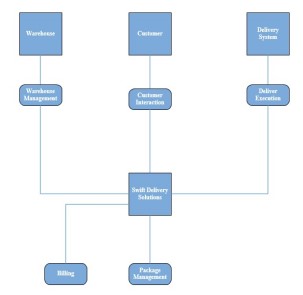
Figure 2: Context Diagram
(Source: Self-developed)
A delivery system's high-level overview is illustrated in the context diagram. It displays the major entities of Swift Delivery Solutions. the Delivery System, the Warehouse, and the Customer are shown in the diagram as entities. The connection between these entities is also shown in the diagram. For instance, the Delivery System communicates with the Customer and is connected to the Warehouse and Swift Delivery Solutions. Without getting into specifics, the figure gives a general overview of the parts of the system. It also illustrates the way they relate to one another.
Level 0 DFD
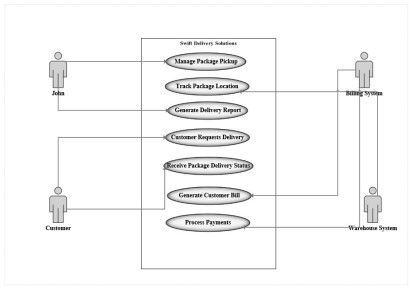
Figure 3: Level 0 DFD
(Source: Self-developed)
The exchanges of the Swift Delivery Solutions system are depicted in this Data Flow Diagram (DFD). John is the owner of the company. He has the authorization to oversee package pickups and tracking. The client gets updates on the status of their product and requests delivery. After the billing system creates client bills then they handle payments. The warehouse system is integrated to offer delivery statuses. Managing package pickup, tracking locations, producing delivery reports, answering client delivery requests, getting package status updates, and managing billing and payments are some of the important system operations. The interaction held between different entities. And lastly, the main delivery system is depicted in the diagram.
ERD Diagram
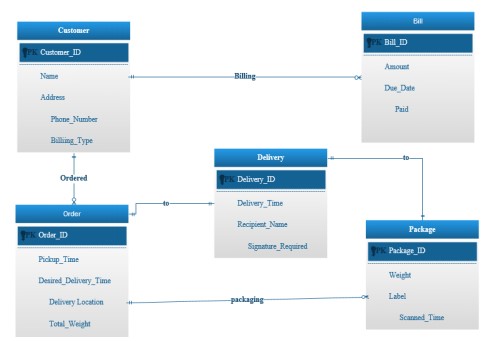
Figure 4: ERD Diagram
(Source: Self-developed)
An Entity Relation diagram for a delivery management system database is shown in the above developed image. It contains entities and their relationships. Customer, Bill, Delivery, Order, and Package are some entities that are mentioned in the diagram. A customer can place several orders. Each order can have multiple deliveries and each delivery includes a package. The diagram illustrates the hierarchical nature of the system. Relevant data is captured by additional entities. Billing and packaging for the system's logistical and financial components are some of additional entities.
Events Table
Table 1: Events Table
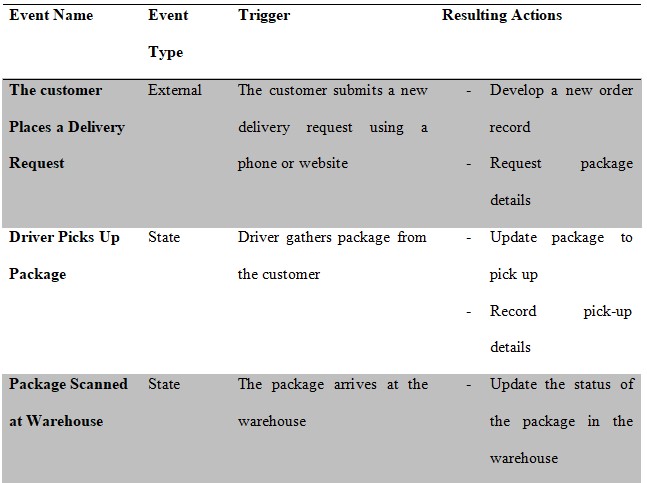
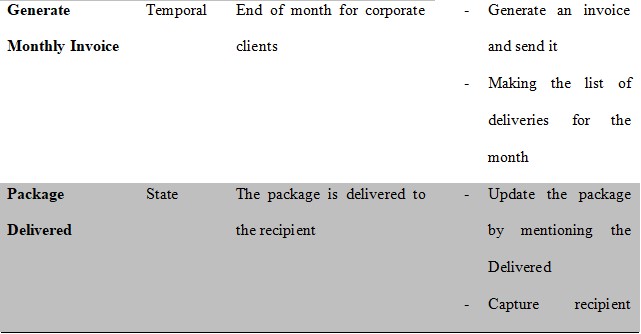

Are you struggling to keep up with the demands of your academic journey? Don't worry, we've got your back!
Exam Question Bank is your trusted partner in achieving academic excellence for all kind of technical and non-technical subjects. Our comprehensive range of academic services is designed to cater to students at every level. Whether you're a high school student, a college undergraduate, or pursuing advanced studies, we have the expertise and resources to support you.
To connect with expert and ask your query click here Exam Question Bank

